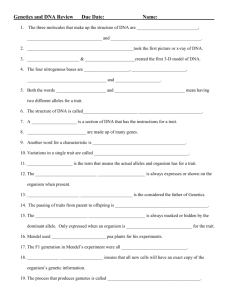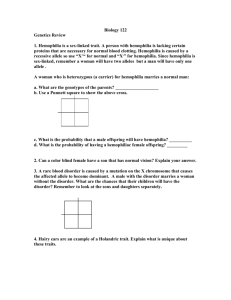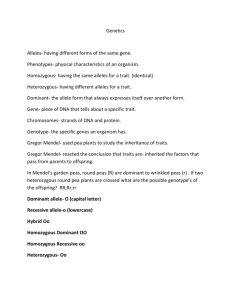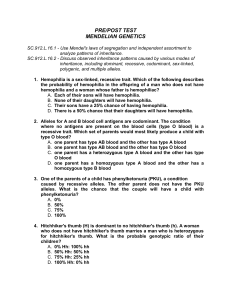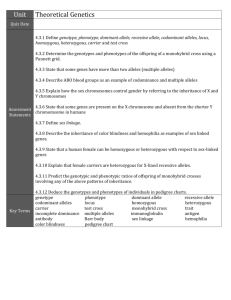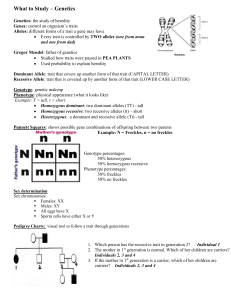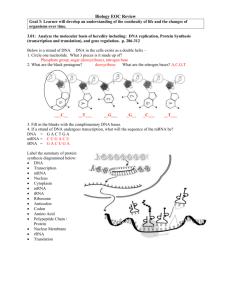Unit 3 Exam Review
advertisement
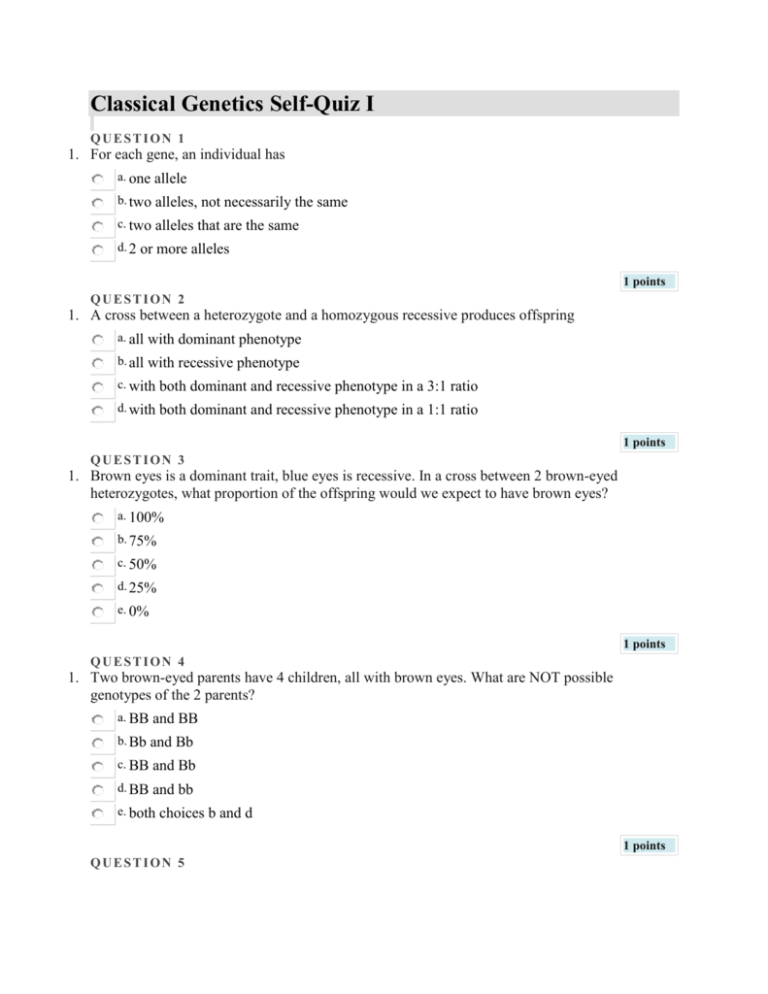
Classical Genetics Self-Quiz I QUESTION 1 1. For each gene, an individual has a. one allele b. two alleles, not necessarily the same c. two alleles that are the same d. 2 or more alleles 1 points QUESTION 2 1. A cross between a heterozygote and a homozygous recessive produces offspring a. all with dominant phenotype b. all with recessive phenotype c. with both dominant and recessive phenotype in a 3:1 ratio d. with both dominant and recessive phenotype in a 1:1 ratio 1 points QUESTION 3 1. Brown eyes is a dominant trait, blue eyes is recessive. In a cross between 2 brown-eyed heterozygotes, what proportion of the offspring would we expect to have brown eyes? a. 100% b. 75% c. 50% d. 25% e. 0% 1 points QUESTION 4 1. Two brown-eyed parents have 4 children, all with brown eyes. What are NOT possible genotypes of the 2 parents? a. BB and BB b. Bb and Bb c. BB and Bb d. BB and bb e. both choices b and d 1 points QUESTION 5 1. A man with brown eyes who is a heterozygote marries a woman with brown eyes who is homozygous. What can we say about the possible eye color of their children? a. They will b. Half all have brown eyes. will have brown eyes. c. 75% will have brown eyes. d. We can't say for sure. 1 points QUESTION 6 1. In snapdragons there is incomplete dominance. One homozygote is red and the other is white. Heterozygotes are pink. What color offspring are expected from a cross between 2 pink plants? a. red b. red and white c. pink d. red, white and pink 1 points QUESTION 7 1. If an individual with Type A blood, whose mother has Type O, marries an individual with Type AB blood what are all the possible offspring blood types? a. A b. A, B c. A, B, AB d. A, B, O e. A, AB 1 points QUESTION 8 1. A Siamese cat has a mostly white fur but black ears and paws because a. the alleles for black fur are only in the feet. b. if tissues are cold the alleles express black fur color c. if tissues are hot the alleles express white fur color d. its feet are homozygous for black but its body is homozygous for white Classical Genetics Self-Quiz II QUESTION 1 1. The ability to roll the tongue is caused by an autosomal dominant allele (R, it is not sex-linked). Bob and his wife Alice can roll their tongues, but 2 of their children cannot. What are the genotypes of Bob and Alice? a. Rr and Rr b. RR c. Rr and Rr and rr d. rr and e. RR rr and RR 1 points QUESTION 2 1. If a boy has a sex-linked trait, such as hemophilia, he inherited it from his a. mother b. father c. both parents d. either parent 1 points QUESTION 3 1. Two carriers of an autosomal recessive genetic disease marry. What are the chances that their children will have the disease? a. 0 b. 1/4 c. 1/2 d. 3/4 e. all will have it 1 points QUESTION 4 1. For an autosomal dominant genetic disease, such as Huntington's, if a normal man marries an affected woman, what proportion of their children would be expected to have the disease? a. all b. 3/4 c. 1/2 d. 1/4 e. none 1 points QUESTION 5 1. A woman who is a carrier for hemophilia (sex-linked trait) marries a man with hemophilia. What is the probability of hemophilia in their children? a. all of the boys and none of the girls will have hemophilia b. all of their children will have hemophilia c. half d. the of both boys and girls will have hemophilia girls will all be carriers and the half the boys will have the disease 1 points QUESTION 6 1. A woman with type O blood has a baby with type A. She claims her boyfriend is the father; he has type B. Can he be the father? a. yes b. no 1 points QUESTION 7 1. Which is an example of a multifactorial trait? a. tongue rolling b. earlobe attachment c. hemophilia d. height 1 points QUESTION 8 1. A woman who is homozygous for normal vision is married to a colorblind man (sex-linked recessive trait). What is the probability of colorblindness in their children? a. 0 b. 0 c. ½ in girls, ½ in boys d. 0 in both girls and boys in girls, 1 in boys Molecular Genetics Self-Quiz QUESTION 1 1. The structure of DNA has been described as a twisted ladder. The rungs of this ladder consist of a. phosphates b. pairs of deoxyribose molecules c. pairs of bases d. individual deoxyribose molecules e. individual base molecules 1 points QUESTION 2 1. If one side of a portion of a DNA molecule has the base sequence ACCTG, what is the sequence in the opposite strand? a. ACCTG b. GTCCA c. GTTCA d. TGGAC 1 points QUESTION 3 1. How many amino acids would be coded for by the following DNA base sequence? AAGTCCTGGAAT a. 12 b. 6 c. 4 d. 3 e. 2 1 points QUESTION 4 1. What is the approximate number of different amino acids that are coded for by DNA? a. 5 b. 10 c. 15 d. 20 e. 30 1 points QUESTION 5 1. Which of the following is the molecule that ferries amino acids to the site of protein synthesis? a. mRNA b. tRNA c. ribosomes d. DNA e. codons 1 points QUESTION 6 1. During replication, DNA is "unzipped by a. ATP b. an enzyme c. mRNA d. tRNA e. ribosomes 1 points QUESTION 7 1. A mutation in which of the following can be passed on to offspring a. a somatic cell b. a germ cell 1 points QUESTION 8 1. In DNA replication, which statement about the 2 resulting copies is correct? a. Each copy is a random mixture of nucleotides from the original 2 stranded molecule. b. One copy is the original molecule, the other is brand new. c. Each copy is made of completely new nucleotides. d. Each copy has one original strand of nucleotides opposite one new one. 1 points QUESTION 9 1. Foreign genes can be inserted into bacteria using a. plasmids b. triplets c. stop codons d. start and stop codons 1 points QUESTION 10 1. Small amounts of DNA can be amplified very rapidly using a. electrophoresis b. plasmids c. PCR d. Bt 1 points QUESTION 11 1. How many codons are there? a. 3 b. 4 c. 20 d. 64
